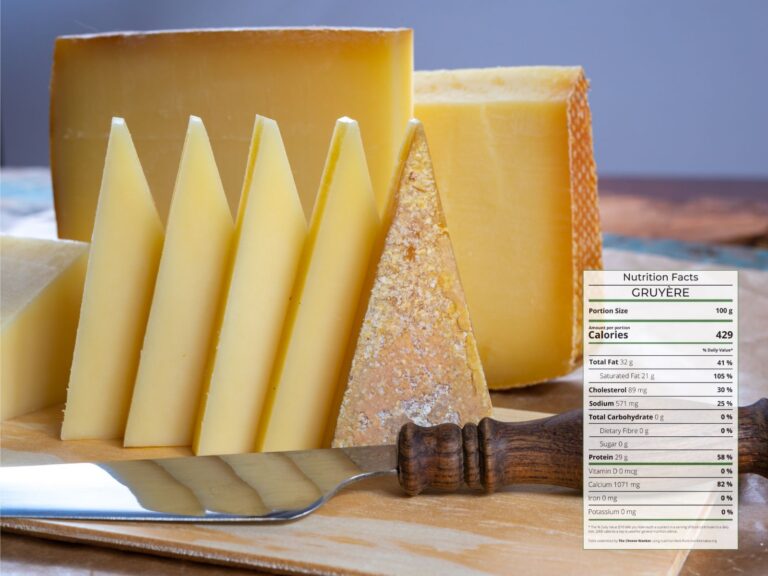Cheese enthusiasts around the world often marvel at the rich and complex flavours of Gruyère cheese. Beyond its delectable taste lies a hidden gem—the enigmatic rind that wraps around each wheel of this renowned Swiss cheese. In this post, we embark on a captivating journey to uncover the secrets of the Gruyère cheese rind. Read on to find out whether you can (and should) eat it.

SEE ALSO: The Cheese Wanker’s comprehensive guide to cheese rinds →
What is Gruyère?
Gruyère cheese holds a hallowed place in the world of artisanal cheeses. Named after the picturesque Swiss district of Gruyère, where it originated centuries ago, this semi-hard cheese has gained global recognition for its exceptional quality and distinctive taste.
Gruyère is renowned for its nutty, slightly sweet, and fruity taste profile, which intensifies as it ages. Moreover, its texture is firm yet pliable, with occasional small crystalline bits that add a delightful crunch.
This versatile cheese is a true culinary powerhouse, equally at home in a fondue, melted on a sandwich, or enjoyed on a cheeseboard accompanied by dried fruits and crusty bread.
You can read all about how this pressed cheese became one of Switzerland’s most famous exports here.
What type of rind does Gruyère have?

Gruyère cheese has a natural rind that forms during the cheesemaking process. Without a doubt, the cream-coloured rind embossed with “LE GRUYÈRE” is just as iconic as the cheese itself.
After the curds are formed and pressed, the cheese wheels are typically brined or dry salted. During this time, the surface of the cheese starts to dry out and forms a protective layer known as the rind.
As the cheese ages, its rind develops and interacts with the environment, allowing various microorganisms to colonise its surface.
You can read more about cheese rinds in our comprehensive guide here.
Rind composition for Gruyère
Molecular
The molecular composition of the Gruyère cheese rind is complex and contributes to its unique organoleptic properties. Since this cheese has a natural rind, its composition is actually the same throughout its paste and rind.
Therefore, Gruyère’s rind consists of a combination of proteins, fats, minerals, water and other organic compounds present in the cheese. The main difference between the rind and the rest of the cheese is the lower water content.
Microbial
The microbial composition of Gruyère rind can vary depending on factors such as the specific cheesemaking process, environmental conditions and ageing duration. Common bacteria found in the rind of Gruyère cheese include species like Brevibacterium aurantiacum¹, which contribute to the distinctive aroma and flavour development.
During maturation, an affineur regularly washes the rind of Gruyère with a saltwater mixture. As a result, the conditions on the cheese’s surface become very hospitable to B. aurantiacum.
Another isolated bacterium on the surface of Gruyère is Corynebacterium glyciniphilum¹. This particular microbe makes a significant contribution to the brick red colour that appears on the rind of this Swiss cheese.
Other bacteria and fungi may also be present, and their interactions contribute to the overall complexity of the cheese’s flavour profile.
Is it safe to eat Gruyère’s rind?
The rind of Gruyère cheese is generally safe to eat, although personal preferences may vary. The formation of the rind is a natural process, and it is an integral part of traditional cheesemaking. However, it is important to note that the rind can contain microorganisms, including harmless bacteria and moulds.
While these microorganisms are generally safe and contribute to the cheese’s flavour, individuals with specific dietary restrictions or compromised immune systems may choose to avoid consuming the rind.
One such category is pregnant women who can reduce their risk of exposure to Listeria by removing the cheese’s rind before eating. You can read more about cheese rind consumption in pregnancy in our dedicated post here.
What does the rind of Gruyère taste like?
The rind of Gruyère cheese typically develops a firm and slightly coarse texture as it ages. It can become dry with an average moisture content of 28%. And form a protective layer that helps preserve the internal moisture of the cheese. The texture may vary depending on the age of the cheese, with younger cheeses having a thinner and less developed rind.
Regarding flavour, the rind of Gruyère cheese contributes significantly to its overall taste. The presence of specific microbial communities contributes to the development of flavours commonly associated with Gruyère. These flavours can include nutty, fruity and slightly earthy notes. The rind’s interaction with the cheese also helps enhance the depth of flavour as the cheese ages.
Learn more about the incredibly complex flavours of Gruyère in our dedicated post here.
Conclusion: you can eat the rind of Gruyère

In conclusion, the rind of Gruyère cheese forms naturally during the cheesemaking process and contains a complex composition of proteins, fats, minerals and microorganisms. It is generally safe to eat, but individual preferences and dietary considerations may influence its consumption.
So, tell me. What do you do with the rind when eating Gruyère? Leave a comment below.
Reference
¹Bacterial Community Diversity & Structure Associated with The Cheese Rind – Lei Wei, Rebecca J. Rubinstein et al.



